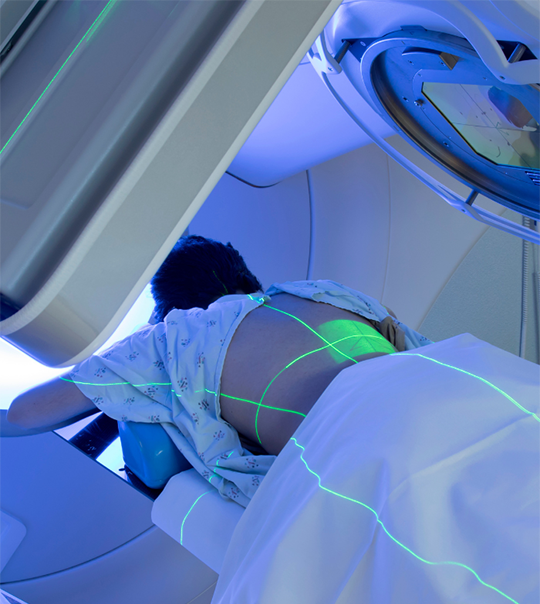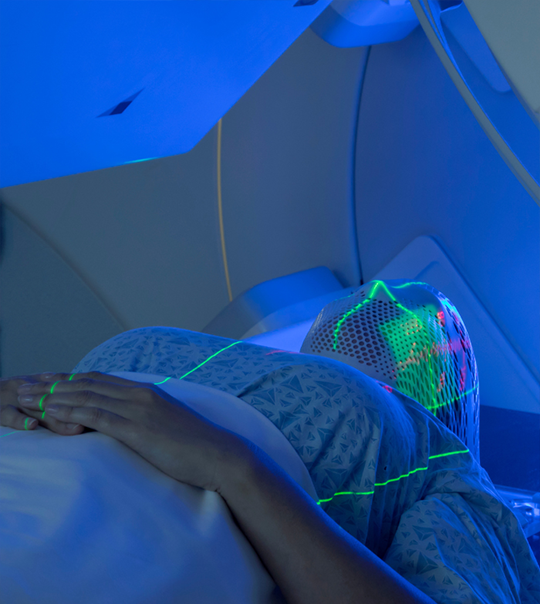
RADIATION TREATMENT
Image-guided radiation therapy
(IGRT)
Image Guided Radiation Therapy (IGRT) is used in combination with either 3D-CRT or IMRT. If your treatment plan includes IGRT, each treatment session will begin with IGRT and will conclude with either 3D-CRT or IMRT (depending on your treatment plan).
Because of the precision allowed by IGRT, your doctor can use higher doses of radiation on the tumor while minimizing or avoiding harm to healthy tissue. This also helps keep radiation side effects such as fatigue, loss of appetite, and nausea, to a minimum.
IGRT is most commonly used when treating the following:
- Tumors in areas of the body that tend to move, such as the lungs, liver, prostate gland, and pancreas
- Tumors near critical organs and tissues such as the brain or the heart
- During treatment of lung cancer, breast cancer, prostate cancer, head and neck cancers, bladder cancer, and many other types of cancers.
What to expect during IGRT
At the start of your IGRT scans, your radiation therapist will position you on the treatment table. The images obtained during IGRT will be compared to the images from your CT simulation and will enable your treatment team to precisely target your tumor during your 3D-CRT or IMRT radiation treatment. Your radiation therapist may reposition you and take more images. Once the exact location of your tumor has been identified, your radiation treatment will begin.
Visit the 3D-CRT or IMRT pages for more information on what to expect during your treatment.
Ways to receive radiation
Radiation as a sole treatment modality
The type and stage of cancer, a patient's medical history, and more all go into the decision of whether and how to use radiation therapy. Radiation therapy can be used on its own to cure or treat early-stage cancer or to prevent a previous cancer from spreading to another area of the body. Radiation therapy may also be used to treat cancer that has spread too much to be cured, but for which some of the symptoms may be relieved. This is known as palliative radiation.
Radiation in combination with surgery
Physicians may recommend radiation prior to surgery to shrink the size of the tumor or when the location restricts surgical options. Radiotherapy can also be used during surgery (intraoperative radiation) to get straight to a cancer without passing through the skin. Patients may be advised to receive radiation after surgery to remove remaining cancer cells. Sometimes radiopharmaceutical therapies are also combined with radiation and surgery; for example, if you have metastatic prostate cancer, your treatment could include agents like radium 223 and Pluvicto, also known as lutetium 177.
Radiation with chemotherapy
When radiation is used in combination with chemotherapy, the treatment is called chemoradiation. Chemotherapy uses anti-cancer drugs to destroy cancer cells, and radiotherapy uses high-energy rays to destroy cancer cells. Chemotherapy can also be used as a radiosensitizer, enhancing the killing effect of radiation therapy on cancer cells.
Radiation to relieve symptoms
Radiation therapy may be recommended to relieve symptoms by reducing the size of the tumor and its effects on surrounding organs and tissues.
Radiation Therapy Resources
Here are some resources to help you better understand your treatment; how to prepare for treatment; and what to expect before, during, and after treatment occurs.
What Foods Should I Eat if Radiation Causes Nausea?
The best foods to eat if radiation causes nausea include those that are bland, easy to digest, and nutritionally dense. Read more to learn which foods to avoid.
Choosing the Right Radiation Oncology Center for You
You get to choose where to receive radiation therapy. But how do you know what the right choice is for you? Here are some top things to consider.
Recovering From Head and Neck Cancer
The recovery time for head and neck cancer varies by patient. Here, we share some of the top factors that can impact your recovery time.
Types of Radiation Therapy
Image-guided radiation therapy (IGRT)
IGRT combines 3-D images with 3D or intensity-modulated radiation therapy to pinpoint and treat cancerous tumors.

Intensity-modulated radiotherapy (IMRT)
IMRT is an advanced form of external radiation treatment that allows precise targeting of tumor cells.

Image-guided radiation therapy (IGRT)
IGRT combines 3-D images with 3D or intensity-modulated radiation therapy to pinpoint and treat cancerous tumors.

Intensity-modulated radiotherapy (IMRT)
IMRT is an advanced form of external radiation treatment that allows precise targeting of tumor cells.

Stereotactic body radiotherapy (SBRT)
SBRT is an advanced type of radiation therapy that delivers high doses of radiation aimed at a very targeted area of the body.

3-D conformal radiation therapy
3-D CRT uses technology to capture 3D representations of the tumor and surrounding organs.

Stereotactic body radiotherapy (SBRT)
SBRT is an advanced type of radiation therapy that delivers high doses of radiation aimed at a very targeted area of the body.

3-D conformal radiation therapy
3-D CRT uses technology to capture 3D representations of the tumor and surrounding organs.

Schedule Your Appointment Today
If you are referred for radiation therapy during your cancer care, you get to choose where to receive treatment. We are here to support and encourage you—call us today to schedule your first appointment with one of our radiation oncologists at the cancer center nearest to you.



